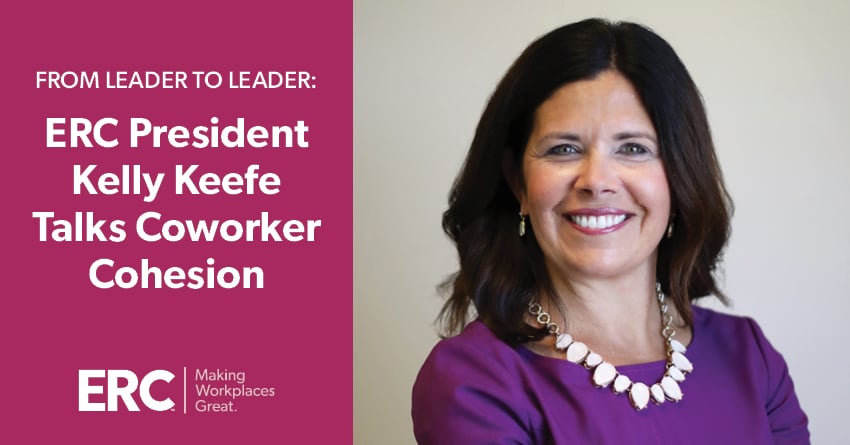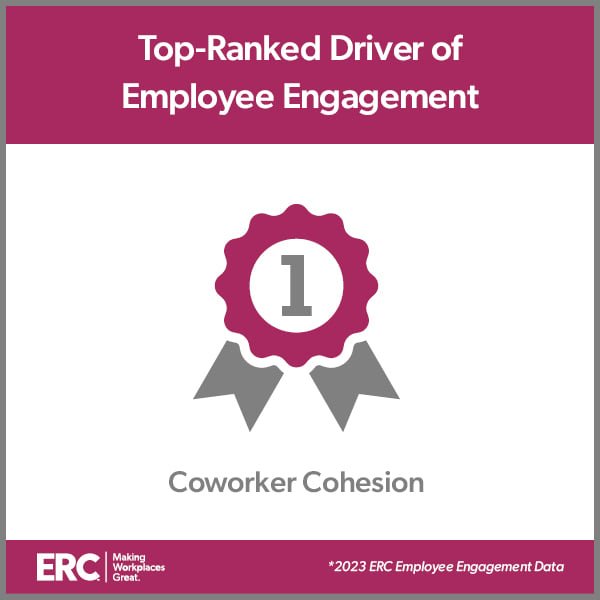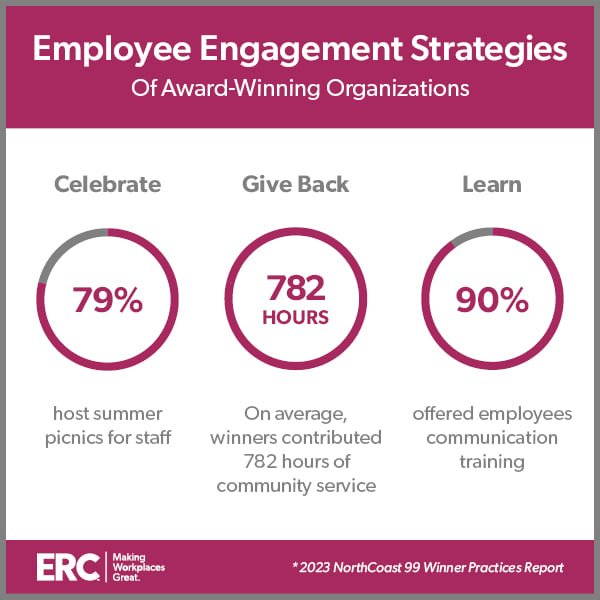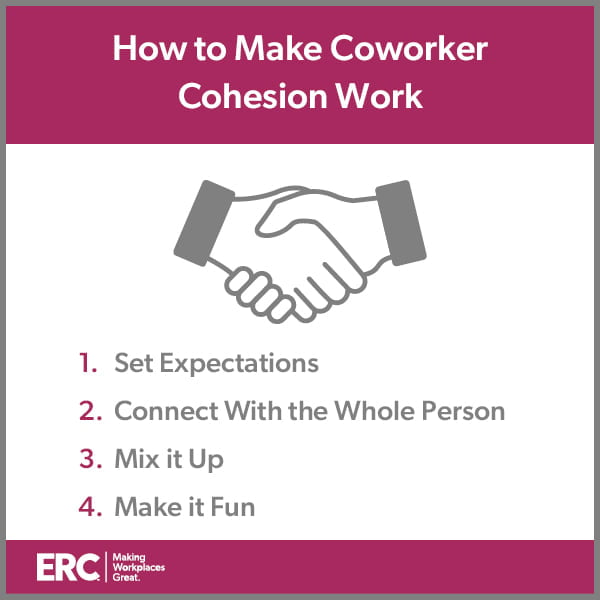
After a global pandemic kept us isolated from family, friends, and in many cases, coworkers, we have emerged with a deepened appreciation and need to simply come together, even in the most ordinary settings – like the workplace.
In the world of employee engagement, a strong interpersonal connection among coworkers, or coworker cohesion, is a key driver of engagement. In fact, throughout the COVID-19 pandemic, and into 2023, “coworker cohesion” consistently received the highest ratings on ERC’s employee engagement surveys.

But building coworker bonds, and ultimately, the ‘stickiness’ between employer and employee, doesn’t happen overnight. It takes time and effort. Based on ERC’s data, we’ve outlined three proven ways to bring your workforce together and how to make these initiatives work so everyone benefits.
Ways to Build Coworker Cohesion
1. Celebrate
Use the achievement of an organizational goal or milestone as a reason to celebrate together in person.
Share the story, recognize key contributors, serve lunch, and include an optional fun activity. Bringing employees together to celebrate something everyone contributed to will help drive performance and engagement. It’s also summer, which is a great time to bring employees together, just for fun!
The standard summer picnic is back in full swing this year with 79% of award-winning organizations hosting summer picnics.
The theme of bonding over shared food is strong with food trucks, ice cream socials, and happy hours. Recreational activities like a group outing to an amusement park, hosting your own field day, or fielding your own rec-league sports team are also popular alternatives.

2. Give Back
Community service is team building at its finest. The impact of coming together for a greater cause, while taking a break from day-to-day work tasks is indisputable.
Beyond team building and bonding, scheduling a service day during the work week or prioritizing service during work hours is a great way to ‘live’ an organizational value of giving back.
Per ERC research, on average, award-winning organizations contributed 782 hours of community service last year alone.
3. Learn
Offering training not only fulfills your organization’s commitment to talent development, but it also provides a shared learning experience among your employees.
Use training to encourage employees to learn more about one another and improve how they relate to one another — personally and professionally.
Consider delivering a course applicable to all, like team building or communication styles. Communication training was the most popular course among award-winning organizations, offered by 90% of Northeast Ohio employers.
How to Make It Work
1. Set Expectations
This is something to plan for, giving advance notice to all. Send a calendar invite with the date, time, location, and details. Have the CEO or President make the announcement and generate excitement around the event. Require attendance. Pay for travel and their time. Start with one get-together per year and aspire to increase the frequency the following year.
2. Connect With the Whole Person
Make sure the agenda includes planned, structured activities as well as free time for employees to mingle. Build in opportunities for work-related discussions as well as personal-life discussions. Include a brief ‘state of the company’ address delivered by leadership. Ensure managers are available for brief, side-bar check-ins with their team members.
Pay attention to as many important details as possible. For example, welcome employees as they arrive, use name tags, select a venue that ideally includes indoor and outdoor spaces, reserve a room that allows groups to come together and spread out, make food and beverages available, build in breaks for quick phone calls, and balance work time with ‘down time.’

3. Mix it Up
When coming together, consider how this opportunity can be used to form new or bolster existing bonds. Mix in leadership with individual contributors. Break down siloed departments, or group teams together that are struggling to work together effectively in these at-work-but-not-doing-work situations.
Bonus points if you throw in some fun icebreakers to make the mixing less awkward and help folks find common ground more quickly.
Arrange in advance for more tenured employees to be assigned to new hires, showing them around, introducing them to coworkers, ensuring they have someone to sit next to during meals and activities, and answering their questions about ‘the way we do things here.’
4. Make it Fun
Keep in mind that “required fun,” often ends up missing the point and can even have the opposite effect. Avoid this pitfall by incorporating “fun” in ways that fit the culture of your organization and the needs of your employees.
Keep the dress code casual, the mood light, and the conversations positive and upbeat. Incorporate music. For both work and non-work activities, where possible, provide two or more options, giving employees a choice. Finally, create safe spaces for employees to be themselves.
Clearly, this is not an exhaustive list of why and how employers can bring their people together, nor are they one-size-fits-all options. Leaders should consider what may or may not work for their organization and adjust accordingly. If you stay focused on what matters most – connecting and engaging – you can’t go wrong!

Kelly Keefe, SHRM-SCP
President, ERC
